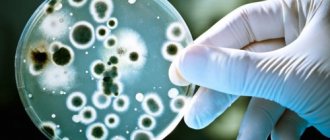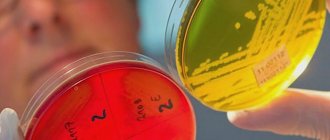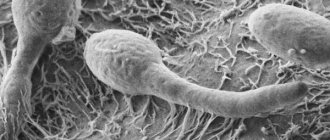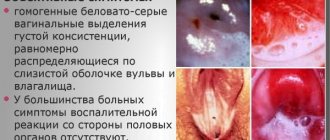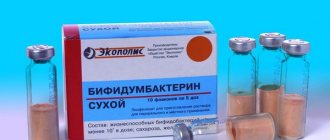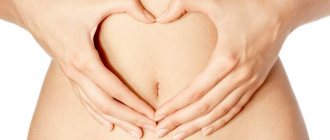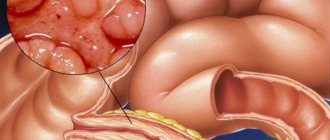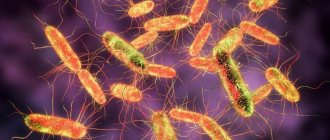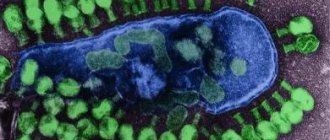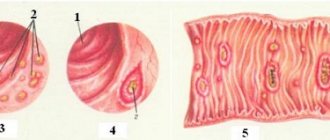Representatives of the intestinal flora
Microbes that are found in the human intestine are divided into 2 large groups - normal microorganisms and opportunistic microorganisms.
- Normal intestinal microflora. Representatives of this group should always be inside the human intestine, as they perform many useful functions. This is the process of digestion of nutrients (splitting and absorption), synthesis of vitamins and essential amino acids, local protective immune reactions. With systemic diseases, the number of representatives of the normal intestinal microflora may decrease, which negatively affects the condition of the digestive canal and the entire body.
- Opportunistic microorganisms. They must be present in the human body, but in small quantities. If a balance is maintained between normal and opportunistic microflora, then the digestive tract functions normally. If the amount of opportunistic microflora increases, the functionality of the intestine decreases. In domestic practice, the term “dysbacteriosis” is adopted, which means a decrease or complete disappearance of normal microflora, the predominance of opportunistic microflora.
Normal
Among the representatives of normal microflora the following are known:
- bifidobacteria - the largest group, responsible for the production of acetic and lactic acid, creates the necessary pH in the intestines, stimulates peristaltic movements, destroys carcinogens and other antigens (immune defense), synthesizes vitamins, normalizes lipid metabolism;
- lactobacilli – stimulate peristalsis, provide local immune protection;
- Escherichia coli (Escherichia non-invasive, non-hemolytic, non-toxigenic) - responsible for antiviral immunity, all functions are not fully understood;
- anaerobic propionobacteria – ensure the maintenance of pH at a stable level, prevent the activation of opportunistic flora;
- streptococci (group of peptococci) – stabilize the process of acid-base balance;
- bacteroids - break down fats, ensure the absorption of nutrients, normalize lipid metabolism;
- enterococci - participate in the digestion reactions of all carbohydrates (fermentation without gas formation).
The above microbial agents are obligate, that is, mandatory in the intestinal microflora of a healthy person.
Opportunistic
In the group of opportunistic microbes there are:
- staphylococci (non-toxigenic strains) – participate in nitrogen metabolism;
- streptococci (non-pathogenic strains) – metabolize carbohydrates and regulate the number of pathogenic microorganisms based on the principle of antagonism;
- various bacilli - functions not fully understood;
- yeast fungi (mainly Candida);
- peptococci – participate in protein metabolism;
- certain strains of E. coli;
- fusobacteria.
We recommend reading:
Escherichiosis: details about the infectious disease
The functional abilities of some of the above microbial agents have not yet been sufficiently studied. It is assumed that they populate the surface of the intestinal mucosa and do not allow pathogenic microbial flora to occupy this place (the principle of competitive antagonism). Opportunistic microbial agents do not exhibit such significant biochemical activity as representatives of obligate flora.
Table 1. Microorganisms in the human intestine.
| Normal | Opportunistic | Pathogenic | |
| Bacteria |
|
|
|
The number of the above bacteria is indicated in the form for testing stool for dysbacteriosis. The results of the study may vary significantly, since much depends on the qualifications of the laboratory assistant and the technical capabilities of the laboratory.
https://youtu.be/LXuVUYKUelM
Compound
In the intestines of a healthy person, there are about 100 billion different bacteria, which belong to several hundred species - according to various sources, from 300 to 1000. But research by scientists has determined that only 30-40 varieties of bacteria actually have a beneficial effect on the functioning of the body. Each person has their own microflora composition. It is influenced by the type of diet, habits, and the presence of diseases of the digestive tract.
Bifidobacteria are the main type of beneficial microorganisms that live in the large intestine. They ensure the maintenance of strong immunity and protect the intestines from the proliferation of pathogenic flora. In addition, bifidobacteria are an important participant in the digestive process. They help break down and absorb proteins and amino acids.
Another group of beneficial microorganisms is lactobacilli. They are also called natural antibiotics, since their main function is to protect the intestines from colonization by pathogenic bacteria, as well as strengthen and maintain the immune system. In addition, beneficial bacteria also include enterococci, E. coli, and bacteroides. These are the main microorganisms that are necessary for the normal functioning of the intestines.
Pathogenic microorganisms of the intestine
These are all known pathogens of intestinal infections. These include:
- salmonella;
- shigella;
- toxigenic and invasive E. coli;
- Vibrio cholerae;
- causative agent of typhoid fever and paratyphoid fever;
- Yersinia.
Normally (in a healthy person) these microbial agents are absent.
All pathogens of intestinal infections are transmitted in 3 ways - food (through contaminated products), water and household contact.
Salmonella
Salmonella is ubiquitous. The source of this infection can be sick people, healthy carriers, as well as animals and birds.
Transmission factors are culinary dishes that do not undergo heat treatment (cream, cakes, salads, scrambled eggs and soufflé). Salmonella carriers working in public catering establishments and child care institutions pose a particular danger to others. Salmonellosis can be a hospital-acquired infection.
We recommend reading:
Does meat rot in the intestines?
A characteristic feature of salmonellosis is loose, foul-smelling stool with an unpleasant odor. The development of severe generalized forms in the form of a septic condition is possible.
Shigella
Found everywhere, in all countries. The source of infection is a person – a patient or a carrier. The clinical picture is varied, but most often there is damage to the distal parts of the intestine - colitis. The clinical picture shows diarrhea mixed with blood, mucus, and pus. Recovery from shigellosis is long-term, as severe dysbiosis can develop.
Toxigenic and invasive E. coli
E. coli contamination is high in all geographical areas. It can be located on household items, inside food products, in water and soil. Very resistant to environmental factors. The clinical picture has no specific signs. Escherichiosis is most severe in children in the first three years of life; infectious-toxic and hypovolemic shock may develop.
Vibrio cholerae
Main article: Cholera: symptoms and treatment
The causative agent of one of the especially dangerous (quarantine) infections. Found in Africa and Southeast Asia. Natural foci of cholera are registered in the south of the Russian Federation and in Ukraine. Cholera is transmitted primarily by water. The clinical picture shows rapid development of severe dehydration. Without medical care, the disease ends in death from acute heart or kidney failure.
Causative agents of typhoid fever and paratyphoid fever
Main article: Typhoid fever
In countries with tropical and subtropical climates, the incidence is high; in countries of the European region, isolated sporadic cases are recorded. The highest risk of infection is in the warm season in countries with a low level of sanitary and hygienic culture. The disease is characterized by prolonged fever, damage to the intestines and lymphatic system. Complications may develop - intestinal bleeding, intestinal perforation and peritonitis. The complicated course of typhoid-paratyphoid diseases can result in the death of the patient.
Meaning
Recently, scientists are increasingly talking about the beneficial functions of intestinal flora. They discovered that it is so important for the normal functioning of the entire body that its slightest violation immediately affects the state of health. Therefore, drugs to restore the balance of microorganisms are now often included in the complex treatment of many diseases.
After all, the normal microflora of the large intestine performs several important tasks in the human body. The most important job of beneficial intestinal bacteria is to participate in the digestion process. They accelerate the absorption of amino acids and vitamins, help break down proteins, and synthesize some digestive enzymes. Another function of microflora is that bacteria produce many vitamins, essential amino acids and other beneficial substances. They are the ones who participate in the synthesis of B vitamins, nicotinic acid, and improve the absorption of iron.
The protective function is that beneficial bacteria prevent the proliferation of pathogenic microorganisms, protecting the body from infectious diseases. In addition, microflora performs an immunomodulatory function - it helps maintain the body's defenses and strengthens the immune system. Beneficial bacteria are involved in the formation of immunoglobulin, which is essential for good health. The cleansing function of microflora is that beneficial microorganisms accelerate the removal of various toxins and metabolic products from the intestines and participate in the neutralization of poisons.
Treatment
Identification of opportunistic flora is not an indication for treatment. Only its significant predominance over representatives of normal microflora requires external intervention. To correct dysbiosis, the following are used:
- probiotics – preparations from bacteria (lacto, bifido), displacing opportunistic flora;
- prebiotics – substances that create conditions favorable for the growth of one’s own microflora (lactulose);
- bacterial phages are special viruses that destroy bacteria.
Pathogenic flora (salmonella, shigella) must be eliminated with the help of antibiotics.
Any treatment requires the attention of a specialist (infectious disease specialist or gastroenterologist).
We recommend reading:
Diet for diarrhea: nutritional principles, foods and menu for the week
In continuation of the topic, be sure to read:
- Escherichia coli: about the bacterium, its types, pathogenic and non-pathogenic strains
- Escherichiosis: details about the infectious disease
- How is rotavirus intestinal infection manifested and treated?
- Details about dysbiosis and methods of its treatment (diet, medications)
- Intestinal infection: symptoms and treatment methods (diet, medications)
- Intestinal dysbiosis in children: symptoms and treatment (diet, medications)
- Bacteriological culture (tank culture) of feces: essence, preparation and analysis
- Dysentery: how is the disease manifested and treated?
- Analysis of stool for disgroup: essence, preparation and delivery of analysis
- Enterococci: about bacteria, normal and pathological existence
What is microflora
Intestinal microflora is a complex of many types of microorganisms that exist in symbiosis with humans and benefit them. At birth, the baby's intestines are just beginning to become colonized with these bacteria due to its interaction with the environment. The formation of normal microflora in children occurs over several years. Usually, only by the age of 12-13 does a child develop the same microflora composition as an adult.
The human digestive tract is not entirely populated by bacteria. They are not present in the stomach and small intestine, as there is very high acidity there, and they simply do not survive. But closer to the large intestine, the number of microorganisms increases.
In the presence of normal intestinal microflora, digestive problems rarely occur. But it often happens that the balance is upset: beneficial bacteria die, and pathogenic ones begin to multiply rapidly. In this case, unpleasant symptoms arise, which are called dysbiosis. Many doctors do not consider it a separate disease, although such a pathology can bring many problems to a person. And it can occur against the background of absolute health of the entire digestive system.
Reasons for violation
Intestinal flora is disturbed in most cases due to the fault of the person himself. His incorrect behavior and nutrition, bad habits, untreated chronic diseases - all this can lead to a change in the balance of microorganisms.
Improper nutrition is one of the main causes of dysbiosis. Disturbance of the intestinal microflora occurs if it receives little dietary fiber, which serves as a breeding ground for beneficial bacteria. In addition, this happens with a monotonous diet, following strict diets, and the predominance of harmful foods in the diet.
The balance of microorganisms can be disrupted by the consumption of fast food, alcoholic beverages, fatty and fried foods, large amounts of preservatives, sweets, baked goods and chemical additives. Because of this, beneficial bacteria die, and the processes of decay and fermentation that develop with such nutrition contribute to the growth of pathogenic microflora.
A common cause of dysbiosis is long-term use of certain medications. First of all, these are antibiotics and antiseptics, which destroy not only pathogenic bacteria, but also beneficial ones. It is especially harmful to take such drugs without a doctor’s prescription, since specialists usually include means for restoring microflora as part of complex treatment. Dysbacteriosis can also be caused by immunosuppressants and hormonal drugs, for example, contraceptives. Passion for enemas and other cleansing procedures can disrupt the microflora, as they simply wash away beneficial bacteria
The body's second line of defense
If microbes still manage to get inside the body, then the second line of defense is activated. It is also a nonspecific barrier in the blood that stops many types of pathogenic microorganisms.
Phagocytes are a type of white blood cell that move through amoeboid action. They form cytoplasmic projections that allow them to surround invading bacteria and engulf them. Phagocytes release digestive enzymes that destroy surrounded microbes before they can do any harm. This process is called phagocytosis.
Symptoms of dysbiosis
When the balance of beneficial and pathogenic bacteria is disrupted, serious changes occur in the body. First of all, they affect the digestive process. In addition, malabsorption of nutrients leads to a general deterioration of the condition. Each person develops an individual reaction to such changes.
But usually dysbiosis is characterized by the following symptoms:
- bowel dysfunction;
- bloating, increased gas formation;
- constipation or diarrhea, often alternating between them;
- stomach ache;
- nausea, vomiting;
- decreased appetite;
- weakness, decreased performance;
- depression, irritability;
- avitaminosis;
- skin allergic reactions.
To effectively treat dysbiosis, you need to take into account its stage. At the initial stage, the balance of microorganisms is only slightly disturbed, which happens, for example, after consuming antibiotics or junk food. At the same time, it is possible to restore the microflora without drugs, only by adjusting the diet, for example, by including more fermented milk products. Indeed, at this stage they often talk about the development of transient or transient dysbiosis. Often the body can cope with it on its own. Serious treatment is necessary at stages 3 and 4 of the pathology. In this case, serious symptoms of dysbiosis appear: stool disturbances, abdominal pain, vitamin deficiency, apathy and chronic fatigue.

